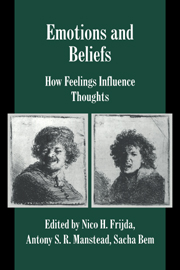Book contents
- Frontmatter
- Contents
- Contributors
- 1 The influence of emotions on beliefs
- 2 Feeling is believing: Some affective influences on belief
- 3 Beliefs through emotions
- 4 The sentiments and beliefs of distributed cognition
- 5 Feeling is believing? The role of processing strategies in mediating affective influences on beliefs
- 6 The formation of beliefs at the interface of affective and cognitive processes
- 7 Anxiety, cognitive biases, and beliefs
- 8 A cognitive dissonance theory perspective on the role of emotion in the maintenance and change of beliefs and attitudes
- 9 Relationship beliefs and emotion: Reciprocal effects
- Index of authors
- Index of subjects
- Studies in Emotion and Social Interaction
3 - Beliefs through emotions
Published online by Cambridge University Press: 10 March 2010
- Frontmatter
- Contents
- Contributors
- 1 The influence of emotions on beliefs
- 2 Feeling is believing: Some affective influences on belief
- 3 Beliefs through emotions
- 4 The sentiments and beliefs of distributed cognition
- 5 Feeling is believing? The role of processing strategies in mediating affective influences on beliefs
- 6 The formation of beliefs at the interface of affective and cognitive processes
- 7 Anxiety, cognitive biases, and beliefs
- 8 A cognitive dissonance theory perspective on the role of emotion in the maintenance and change of beliefs and attitudes
- 9 Relationship beliefs and emotion: Reciprocal effects
- Index of authors
- Index of subjects
- Studies in Emotion and Social Interaction
Summary
Emotions influence beliefs. This is a classical assumption. People's emotions, according to this assumption, determine what they think, and what they think is true. We use the word “belief” for a proposition that a person considers to be true. The truth of most propositions is not objectively fixed. Most propositions affirmed in beliefs go beyond the mere occurrence of observable facts. They extend to the causes or intentions behind events, their likely consequences, and the enduring properties of things or persons that make them behave in a particular manner. That some harm was due because a particular individual caused it, that he caused it because he intended to effect that harm, that he did so because he has an evil nature – all are beliefs in this sense.
Thus the thesis that this chapter examines is that emotions influence beliefs. We will first present some evidence for this thesis. We will then try to show that it is of the nature of emotions to have this influence, particularly when those emotions have certain properties or arise under certain conditions, owing to the properties of emotional thinking generally. These properties and conditions are able to influence beliefs because of the properties of belief formation in general.
Emotions influence beliefs in basically two ways. They may give rise to beliefs where none existed, or change existing beliefs; and they may enhance or decrease the strength with which a belief is held.
The notion of “belief strength” is being used to refer to a number of phenomena that may or may not occur together; we do not know. Some beliefs are extreme, and without nuance.
- Type
- Chapter
- Information
- Emotions and BeliefsHow Feelings Influence Thoughts, pp. 45 - 77Publisher: Cambridge University PressPrint publication year: 2000
- 69
- Cited by



